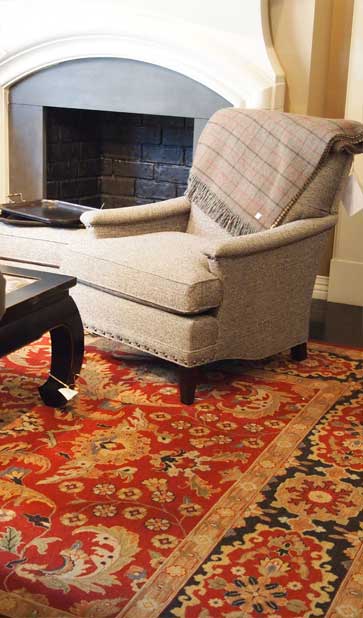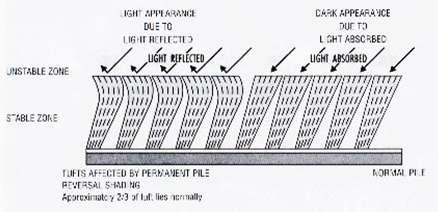 |
Before We Clean
Pre-Inspection
We carry out a thorough pre inspection of every rug before it is cleaned. Pre-Inspection is very important as it brings to our attention anything which we may feel needs to be mentioned to the client prior to cleaning and also allows us to adapt our cleaning process depending on what is discovered. Below are a few of the more common existing conditions found in many rugs which we document in our inspection reports.
Abrash
Many handmade rugs will show an inconsistent dying pattern known as abrash. This is due to the rug pile being made with wool which has been dyed in different batches. These batches will have slight irregularities in the way they are dyed and so colour variations occur. Abrash will always show in straight horizontal sections. It may not be visible when the rug is dirty as the soil disguises the subtle variations in colour however if it is present it will show once the rug is cleaned. Abrash must not be considered a defect in the rug making process and does not devalue the rug. It is a natural characteristic of the rug which many people would argue actually enhances its beauty and crafted charm. In fact some machine made rugs are now given a false abrash look to give them added charm and a more authentic appearance.
White Knots
White knots are another pre-existing condition part of the craft of handmade rugs, which can sometimes become more apparent after cleaning. The foundations of most natural fibre rugs are made of white cotton. The foundations consists of warps running the length of the rug and wefts running horizontally. As wool or silk is knotted on to this foundation and tightly packed the cotton can sometimes break. As these warps and wefts cannot be replaced they have to be cut and tied which results in knots. These knots are cut down so that they are hidden in the pile. As the rug wears down these white knots can begin to appear although they are sometimes not visible if the rug is dirty. If they appear after cleaning they can usually be spot dyed to hide them.
Pile Reversal

Also known as shading or pooling, this is a condition which causes variations in the direction of the pile in the rug. Light will reflect differently depending on the direction of the pile and so shaded areas will be visible. The reason for pile reversal is still unknown and also affects wall to wall carpet. It is more common in longer pile carpets such as Chinese wool rugs .We can sometimes improve pile reversal by thoroughly grooming and setting the pile after cleaning.
Urine Damage
One of the most serious conditions possible in a natural rug is urine damage. Unfortunately urine can cause stains which can become permanent within minutes of contact. They must however be professionally neutralised and rinsed otherwise they will cause further damage to the fibres. Having rugs treated with a fabric protector treatment will decrease the likelihood of a permanent stain as it will allow you time to absorb the urine before it is able to penetrate the fibre. It can also cause latent damage of colour run due to the alkaline pH of urine.
Colour Run
Many rugs which we receive will have pre-existing colour run problems. There are two main causes of colour run:
- First wash after rug weaving: After a rug is weaved it is usually given an initial wash which can sometimes cause darker dyes, such as the deep reds , blacks and dark blues, to bleed into the lighter areas of the rug. This is most commonly seen in village and nomadic rugs where quite often excess dyes were not properly removed from the wool before the rug was woven. Sometimes the water being used to wash the new rug is too alkaline causing it to break the acid bond between the dye and the wool fibres.
- Incorrect previous cleaning: It is common for us to pH test a rug in our pre-inspection, and to find it to be very alkaline. This is usually due to the rug being previously cleaned incorrectly by another company. A rug which is highly alkaline can bleed as soon as it comes into contact with water as the acid bond between the dye and the fibre has been destabilized.
Dye Testing
- When the yarn used to make a rug is dyed it goes through a process of being set called the mordant process (from the Latin 'modere', to bite). This involves using a metal salt which helps the dye to bind with the fibres. The wool is then rinsed to remove any excess dye. The lack of running water in some areas of the Middle East means that some rugs will contain wool which has not been rinsed properly and can therefore bleed.
- Some rug dyes will not be colourfast and may migrate when exposed to moisture or a wet cleaning solution. Some rugs may even dry crock (colour transfer by rubbing in a dry state). We therefore need to test each and every rug prior to cleaning. This will help us to determine the safest way to proceed. Rugs which bleed may still be wet cleanable if we are able to set the dyes. This is usually done with a mild acetic acid. If we are unable to make the dyes stable then we will either clean the rugs in a way that allows us to safely remove the excess dye or use a low moisture method of cleaning. A small number of rugs which we test will not be cleanable at all and so the only option is for us to use a dry powder process or solvent cleaning process and stop at this stage.
pH State of Rug
- The pH state or rug is important for two reasons. It can help identify any unusual spots or stains which may be present. By determining what caused the spots one is able to pre-treat these areas more effectively prior to the cleaning process. Secondly, pH can determine that a rug is not in a very alkaline state. Because the dyes used in rugs are acid, any serious altering of the fibre's pH will result in destabilising of the dye-fibre bond. A rug which has previously been cleaned using alkaline chemicals and not rinsed properly may have a pH which is not acidic. Repeated cleaning in this way can eventually cause a rug to colour run. Any rugs which show an alkaline pH reading should be first corrected prior to cleaning.
- Mechanical Beating & Air Dusting
- Dry soil is your rug's biggest enemy...
- A rug can hold up to 4 kg of dirt per square meter before it even looks dirty. In fact, studies have proven that over 75% of the soil found in a rug will be dry dirt. All this dry soil and grit abrades the rug down and damages the fibres over time as people walk over it. This soil must be fully removed prior to cleaning otherwise the washing process will create 'mud' which will 'wick' back up the fibres during the drying process.
|

